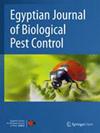Development of potential microbial agents with two new entomopathogenic fungal strains to control the red palm weevil Rhynchophorus ferrugineus (Olivier) (Coleoptera: Curculionidae)
IF 2.1
3区 农林科学
Q1 ENTOMOLOGY
引用次数: 0
Abstract
Abstract Background Entomopathogenic fungi, representing a class of microbial agent, have been widely used in the field of pest management. The objective of this work was to isolate different species of fungi and to evaluate their virulence against the destructive and invasive red palm weevil (RPW), Rhynchophorus ferrugineus (Olivier) (Coleoptera: Curculionidae). Results Two new entomopathogenic fungal strains isolated from dead diseased RPWs were identified as Metarhizium anisopliae ZZ-A1 and Fusarium oxysporum ZZ-L1 using growth characteristics, morphology, and rDNA-ITS sequence amplification. Bioassays showed that M. anisopliae ZZ-A1 strain exhibited significantly higher corrected mortality than F. oxysporum ZZ-L1 strain (90.92 vs. 77.28%) in fourth instar RPW larvae 12 days after treatment with a concentration of 1.0 × 10 10 conidia/ml, as well as low median lethal concentration (LC 50 ) and median lethal time (LT 50 ) values. Conclusions The results suggest that both fungal isolates can potentially be developed as effective and persistent a microbial agent against this widespread pest, RPW. However, M. anisopliae ZZ-A1 showed relatively higher insecticidal activity than F. oxysporum ZZ-L1.两株新型昆虫病原真菌拮抗红棕榈象鼻虫(鞘翅目:麻象科)的研究
摘要背景昆虫病原真菌是一类微生物制剂,在害虫防治领域有着广泛的应用。本研究的目的是分离不同种类的真菌,并评价其对具有破坏性和侵入性的红棕榈象(RPW), Rhynchophorus ferrugineus (Olivier)(鞘翅目:Curculionidae)的毒力。结果通过生长特征、形态特征和rDNA-ITS序列扩增,鉴定出2株新的昆虫病原真菌,分别为绿僵菌ZZ-A1和尖孢镰刀菌ZZ-L1。生物测定结果表明,在1.0 × 10个分生菌/ml处理12 d后,绿僵菌z - a1菌株对4龄RPW幼虫的校正死亡率(90.92比77.28%)显著高于尖孢菌z - l1菌株,且中位致死浓度(lc50)和中位致死时间(l50)较低。结论这两种真菌分离株均可开发为一种有效且持久的微生物制剂,用于防治这种广泛存在的害虫。而绿僵菌ZZ-A1的杀虫活性高于尖孢菌ZZ-L1。
本文章由计算机程序翻译,如有差异,请以英文原文为准。
求助全文
约1分钟内获得全文
求助全文
来源期刊
CiteScore
4.90
自引率
16.70%
发文量
128
审稿时长
>12 weeks
期刊介绍:
The Egyptian Journal of Biological Pest Control is a periodic scientific journal published by the Egyptian Society for Biological Control of Pests (ESBCP) in collaboration with SpringerNature. The journal aims to publish internationally peer-reviewed, high-quality research articles in the field of biological and integrated pest control (non-chemical control). The journal publishes review articles, original papers, conference reports, book reviews, editorials, laboratory reports, technical notes and short communications.

 求助内容:
求助内容: 应助结果提醒方式:
应助结果提醒方式:


